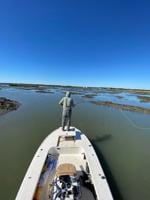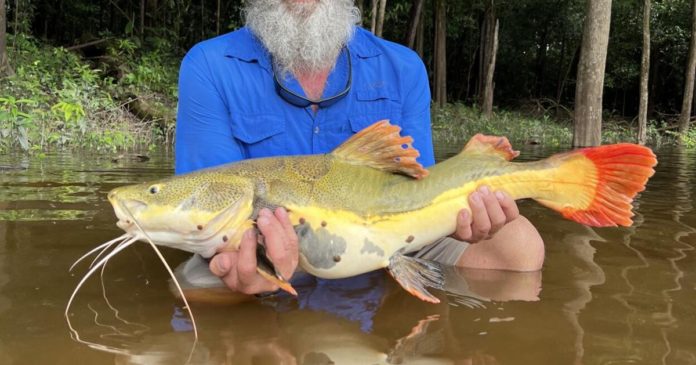Ask a group of freshwater anglers their dream fishing destination and in all likelihood more than one will mention traveling to the Amazon River to fish for peacock bass.
The Amazon is an exotic equatorial locale inhabited by a variety of dangerous wildlife, giant anacondas and toothy piranhas quickly come to mind, as well as the beautifully colored peacock bass, a fish that battles like an MMA fighter and destroys fishing tackle.
In these days of COVID-19, traveling to the Amazon can almost be as challenging as the fishing itself. But Mount Pleasant businessman Jason Bundy and two of his longtime friends from Charleston, Jim Abdella and Mark Cook, managed to overcome numerous obstacles and make a December trip to do battle with the peacocks.
The peacock fishing was spectacular, and Abdella landed a beautiful Amazon redtail catfish that was one of the trips highlights. But Bundy returned home frustrated by one species that has managed to elude him.
“Jim, Mark and I caught hundreds of fish of various species, ranging from peacock bass, piranha, payara, arawana and several species of catfish. I hooked four arapaima and caught zero. I got my butt handed to me by the arapaima. I am now 0 for 7. I have never been beaten by any fish seven times. They are a tough one and I hope that I will land one someday,” Bundy said of an air-breathing species that can weigh several hundred pounds.
Along with the fish, there were other challenges as well.

Jason Bundy of Mount Pleasant shows a big three-barred peacock bass caught on a recent trip to the Amazon. Provided/Jim Abdella
“I’ve been to a lot of countries and this was the most challenging and frustrating trip ever,” Bundy said, adding that the airlines canceled or rescheduled flights at least six times. In pre-COVID times, anglers heading to the Amazon would fly first to Miami and then catch a flight to Manaus, Brazil, before heading out to the fishing destination.
But two major U.S. airlines have eliminated Manaus as a direct destination, forcing anglers to fly to Sao Paulo, 4½ hours flying time beyond Manaus, then catch another flight to Manaus. Factor in flying time and layovers, Bundy, Abdella and Cook spent an extra 11½ hours travel time on the journey to Brazil and an extra 15½ hours on their return. Bundy said that in addition to a valid passport, travelers also must have a negative COVID test within 72 hours of departure, something that cost them approximately $275 each in the U.S. and $28 for the COVID test in Brazil.
You need stout fishing tackle for the peacocks. Bundy’s fishing rigs consist of Shimano Curado reels with a 7.5-1 retrieval ratio spooled with 65-pound test braided line and medium-heavy rods.
“You need the high speed retrieval. The faster the lure across the surface, the better chances of a strike. Peacock bass are so predatory and territorial. They strike not out of hunger but because you’re there. Your lure just makes them mad. These fish are incredibly strong, incredibly powerful. You need a rod with good backbone so you can horse them out of the roots,” he said.
“And you really need the heavy line. My first trip to Brazil, about 30 years ago, I was looking at the IGFA records and I thought I could set a record. I took 30-pound test. When I got into the boat the guide grabbed my rod and started popping the line back and forth and said no. He grabbed one of his rods and tried to hand it to me but I said I was going to use my rods. Five fish in a row hit and popped the line on the strike. The guide cleared his throat and I looked back and he was holding one of his rods with the 65-pound test line.”
Peacocks not only can snap the heavy fishing line, they often break or straighten the hooks on lures, so anglers use 5X strong hooks on their large, 6- to 8-inch topwater baits with props on both ends to make a big surface racket. Bundy said large jigs worked well when water levels were high. And no swivels, snaps, leaders or other attachments. It’s best to tie your lure directly to the heavy braid.

Mark Cook caught this big three-barred peacock bass on a recent trip to the Amazon. Provided/Jason Bundy
Picking the right outfitter is crucial to fishing success. Bundy has used numerous outfitters for peacock trips to Brazil and through experience has learned not to take all of the outfitters at their word. He generally carries 10 to 12 rods and reels for him and his friends to use, something that really came into play on a December 2020 trip to the Amazon.
“An outfitter who had been after me for years to use his outfit said ‘I know many other people will come to me through you.’ He supposedly had all the gear and said you don’t need to bring anything. We had eight fishermen and he had only six rods and reels. Luckily, I bring my own gear so I was able to help everybody. I was pretty frustrated.
“I asked him what was his plan. (It was) to let one person fish for half a day, then switch rods and let the other person fish half a day and watch. That was unacceptable. Honestly, it was horrible, embarrassing,” Bundy said.
On the December 2021 trip, Bundy used an outfitter who had negotiated an agreement with an indigenous Amazon tribe that owns the fishing rights on the river. They took a float plane from Manaus to the camp, which consisted of four floating two-man cabins pulled onto a sandy shore, along with a floating dining hall and floating accommodations for the crew.
The cabins have two bunks, shower, toilet and air conditioning. Bundy said meals are excellent, something different each day. He said it’s easy to gain weight because of the cuisine even though you are working so hard while fishing. After dining the anglers gather around the campfire before heading to bed.
“I like this because you fly into remote areas and you are the only ones fishing that area. So there’s very little fishing pressure,” Bundy said. “If the fishing is bad one day, you will come back the next day and they will move the camp while you’re out fishing. They’ll beach these two-man cabins on a sandbar someplace. We usually swim in the river but didn’t this time because there were more caiman (a relative of the alligator) than I’ve ever seen in my life, and they were large caiman. So no swimming this time.”
Two anglers and a guide fish out of shallow-draft aluminum boats equipped with a fuel efficient outboard and a trolling motor, sometimes making a 45-minute run from camp.
“You see a tremendous amount of wildlife. I’ve seen jaguars. I’ve seen anacondas. Beautiful birds, toucans. We’ve had monkeys throw stuff at us,” he said.
Adventures like this don’t come cheap, but Bundy said you get what you pay for. Less expensive trips are $4,000-4,500 for seven days while the high-end camps that are more remote go for $5,000-6,000. When you factor in airfare, tips and miscellaneous expenses you probably should budget $8,000-$8,500.
“The fishing pressure is completely different in these remote locations. You pay more, but it’s pretty spectacular fishing. On one of my trips we caught 1,786 peacocks alone, and another 1,300-1,400 other species. That’s six fishermen over a seven-day period,” Bundy said.

Bundy’s biggest peacock thus far is 22½ pounds.
“That has a lot to do with the guide service,” he said. “If you’re going really remote you’ve got a better chance at the beast. If you’re going where everybody else is fishing, the beast has learned its lesson.”
Bundy, who has been to Brazil 18 times, said the most recent trip tops them all.
“It was the most amazing trip I have ever had,” he said. “Not necessarily by the number of fish, but most certainly because I got to share it with my two best lifelong friends.”
Credit: Source link






























